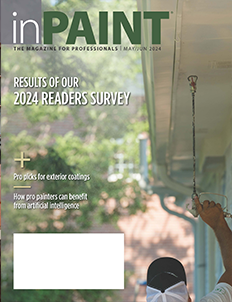Social Media Reputation Building
 With apologies to fans of The Exorcist, we’re about to cite some numbers that will make your head spin.
With apologies to fans of The Exorcist, we’re about to cite some numbers that will make your head spin.
Approximately 73% of online adults now use a social networking site of some kind, according to Social Media Report 2013 of Pew Research Center’s Internet & American Life Project. Social networking giant Facebook alone has one billion users worldwide. What’s more, Pew Research Center shows some 42% of online adults are now using multiple social networking sites.
What do those numbers mean for paint professionals and service companies on the consumer front line?
Potential business, and lots of it. But only if you can tiptoe through the social media minefield of good and bad reviews.
Enter Andy Beal, founder and chief executive officer of Trackur.com, a social media monitoring company with more than 70,000 clients across the country—from mom-and-pops to Fortune 500 mega-corporations. Beal knows a thing or two about dodging social media bullets and even recovering from online review injuries.
What is Trackur.com?
Trackur.com, in a nutshell, is a self-service tool that helps individuals, small businesses, and large corporations monitor what is being said about them online. Trackur utilizes a user-friendly dashboard that covers a gamut of services and marketing needs.
“We monitor any online media: the mainstream media like the The Wall Street Journal, CBS News, Fox, Twitter, Facebook, Google+, videos, forums, reviews, etc.,” said Beal. “The way it’s set up is to alert our customers to the mention of their company name, their product, their executives, whatever it may be, and whatever is being discussed. They can see what’s being said, see whether it’s positive or negative, and see how influential the people are who are saying it.”
Handling the ‘truth’ about your business
Studying surveys, Beal said only 24% of companies plan to monitor their online reputation in 2014.
“A lot of businesses are still in the reactive stage, that is, they don’t pay attention to what is being said about them online,” he says. “These businesses don’t care until something negative happens to them, and then that becomes their wake-up call. All of a sudden, they’re doing everything they can to make sure it doesn’t happen again.”
Beal doesn’t feel social media follows the old adage: any publicity is good publicity. But instead, social media merely emphasizes the importance of good business practices. How well did you treat your customer? Did you finish the job on time? Did you surprise someone with hidden fees? Delivering on promises is key to a positive online reputation, he emphasized.
Fixing it
Beal feels a negative review is a learning opportunity.
“If you get a negative review, you need to figure out: ‘How did this happen? How do we make this customer happy, and how do we correct the situation so that it never happens again?’” he added.
He also feels companies should discover their centers of influence, those social media sites that cater to their specific demographic or specialty.
“You don’t have to be on every single social network and forum. You need to know where your customers tend to hang out, and pay attention to it. Make it a priority to have a good reputation in those channels,” Beal said.
And if you’re dealing with a negative online review, don’t give up hope. Beal says there is plenty of research that shows you can win a customer back.
“Most of the time, if you apologize and show that you’re contrite, you can win back their trust,” Beal concludes. “But you have to put your own pride aside. A lot of small businesses … they get defensive. My advice: Take a breath. Don’t take it personally. Make it right.




